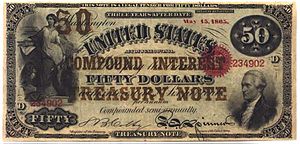Compound Interest Treasury Note
- Compound Interest Treasury Note
-

US Compound Interest Treasury Note $
50
Compound Interest Treasury Notes were emissions of the United States Treasury Department authorized in 1863 and 1864 with aspects of both paper money and debt. They were issued in denominations of $10, $20, $50, $100, $500 and $1000. They matured for three years until they could be redeemed and brought 6 percent interest.[1]
References
- ^ Hessler, Gene and Chambliss, Carlson (2006). The Comprehensive Catalog of U.S. Paper Money, 7th edition, Port Clinton, Ohio: BNR Press ISBN 0-931960-66-5.
| v · d · eObsolete United States currency and coinage |
|
| Topics |
|
|
| Coins |
|
|
| Gold coins |
|
|
| Currency |
|
|
| Patterns |
|
|
Categories: - Money stubs
- Historical currencies of the United States
- Notes
Wikimedia Foundation.
2010.
Look at other dictionaries:
Demand Note — This article is about the Demand Notes issued by the U.S. government. For demand note referring to any promissory note that is payable on demand, see promissory note. Top row: The distinctive green ink used on the backs of Demand Notes gave rise… … Wikipedia
National Bank Note — $10 National Bank Note, Series 1882. The vignette at left shows Benjamin Franklin conducting the famous Kite experiment. National Bank Notes were United States currency banknotes issued by National banks chartered by the United States Government … Wikipedia
National Gold Bank Note — Contents 1 History 2 Series overview 3 References 4 External links History National Gold Bank Notes were banknotes th … Wikipedia
Interest — For other uses, see Interest (disambiguation). Interest is a fee paid by a borrower of assets to the owner as a form of compensation for the use of the assets. It is most commonly the price paid for the use of borrowed money,[1] or money earned… … Wikipedia
United States ten-dollar bill — The United States ten dollar bill ($10) is a denomination of United States currency. The first U.S. Secretary of the Treasury, Alexander Hamilton is currently featured on the obverse of the bill, while the U.S. Treasury is featured on the reverse … Wikipedia
List of United States Presidents by currency appearances — This is a complete list of United States Presidents by currency appearances. The President of the United States has appeared on official banknotes, coins for circulation and commemorative coins in the United States, the Confederate States of… … Wikipedia
United States dollar — USD redirects here. For other uses, see USD (disambiguation). United States dollar … Wikipedia
United States fifty-dollar bill — The United States fifty dollar bill ($50) is a denomination of United States currency. U.S. President Ulysses S. Grant is currently featured on the obverse, while the U.S. Capitol is featured on the reverse. All $50 bills issued today are Federal … Wikipedia
Large denominations of United States currency — The base currency of the United States is the U.S. dollar, and is printed on bills in denominations of $1, $2, $5, $10, $20, $50, and $100. At one time, however, it also included five larger denominations. High denomination currency was prevalent … Wikipedia
Obsolete denominations of United States currency — The United States has produced several coins and banknotes of its dollar which no longer circulate or have been disused. Some, like the half cent coin were removed due to inflation reducing their value while others such as the two cent and twenty … Wikipedia

